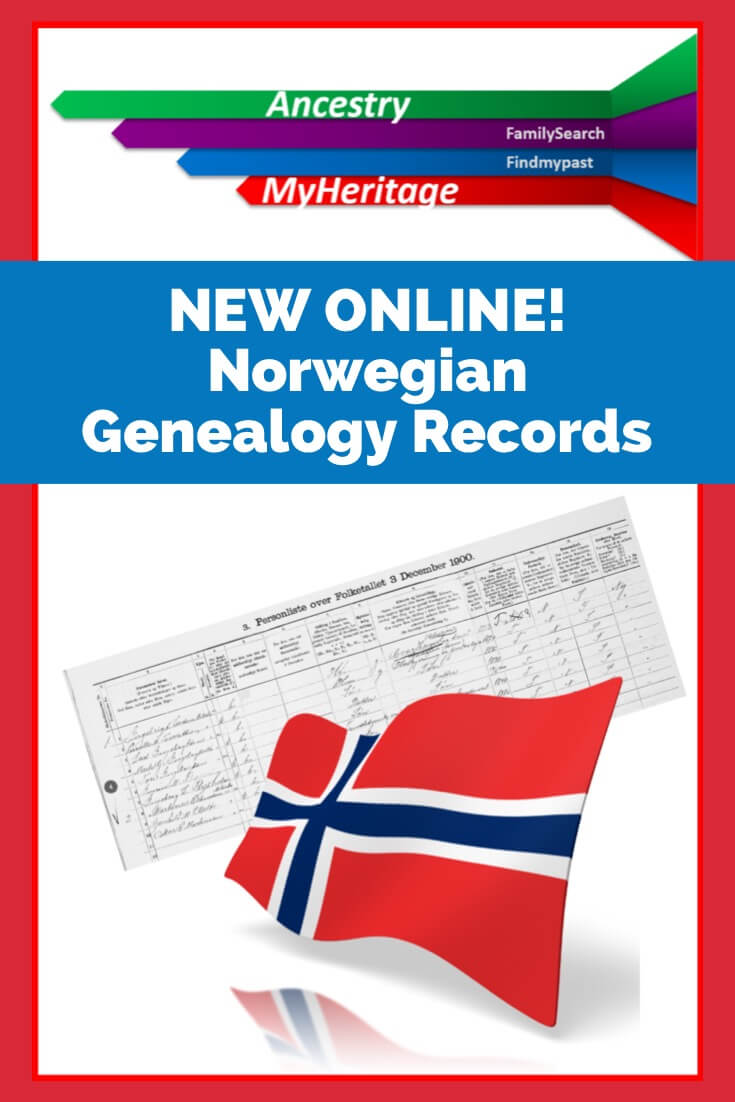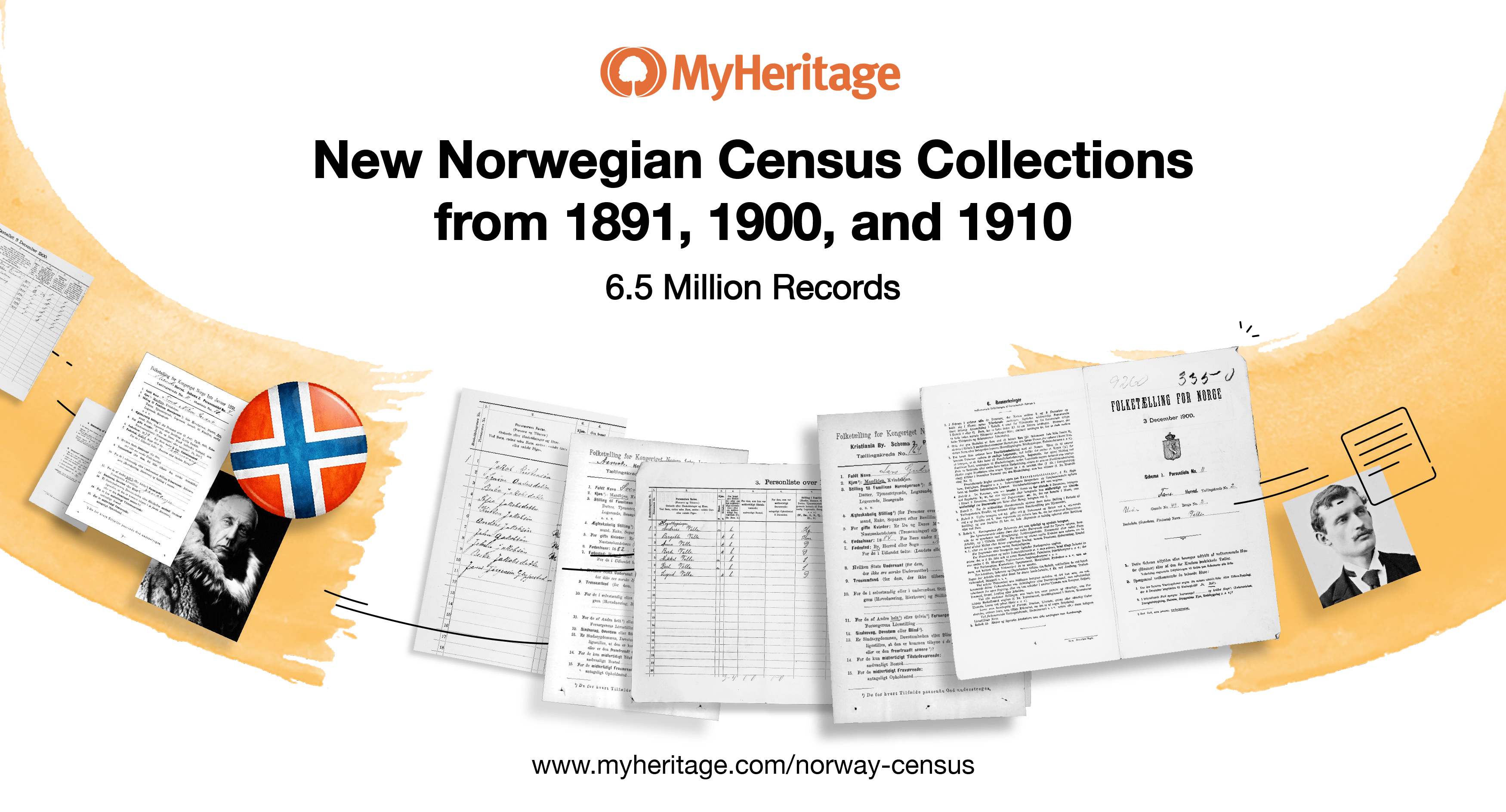Blog

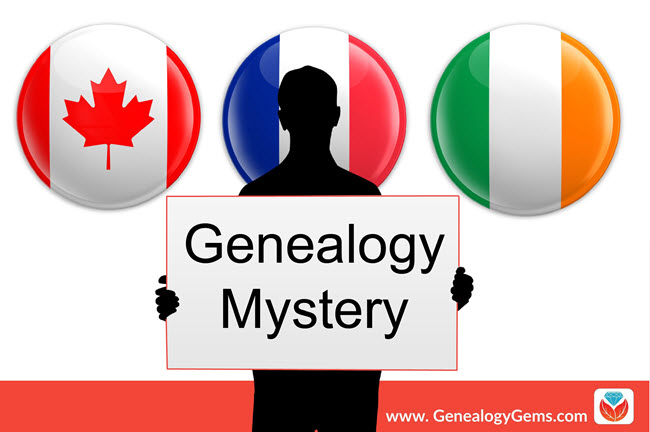
Do You Know Where Your Ancestors are Really From? A French-Canadian-Irish Genealogy Mystery
Read this genealogy mystery from a Canadian family with French and Irish roots. You’ll see the value of considering varied surname spellings, watching for other relatives in census records, using church records, and compiling clues from several sources to get a better picture of the past.
Thanks to Carolyn Tolman, Project Manager at Legacy Tree Genealogists, for this guest post.

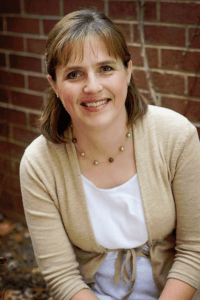 Recently we were contacted by a client who requested we begin researching her direct paternal ancestor. This ancestor was named John Lucy, of Ontario, Canada, and was of alleged Irish heritage.
Recently we were contacted by a client who requested we begin researching her direct paternal ancestor. This ancestor was named John Lucy, of Ontario, Canada, and was of alleged Irish heritage.
Our client explained that her father had recently died and that he would have loved to know the history of his name. She had been trying to trace the Lucy line herself and was not having success.
Though she wished she had begun the research before he passed, she felt this was a way for her to honor her father’s life. She was also planning a trip to Ireland soon and hoped to visit her ancestral towns.
She said “I would be so happy to just make the first connection back to the UK. That is what my father always wanted to know.”
Unraveling a genealogy mystery: Methodist or Catholic? Irish or French?
A survey of Canadian censuses between 1871 and 1901 established that John Lucy was born in Cumberland, Ontario in the early 1840s, and was Wesleyan Methodist by way of religion. However, neither John Lucy nor any of his children appeared in the Wesleyan Methodist baptism records in the Cumberland area. At this point, research temporarily halted as we had reached the end of a project.
In the meantime, the client located a Wesleyan Methodist marriage index entry for a John Lussiers and Ann Hannah who married in Cumberland on 22 August 1864, and she requested that we recommence researching the Lucy family.
In the marriage record, John was reportedly born in Cumberland and was the son of “E[xe]brus and Delia Lussiers.” The name “E[xe]brus” was obviously a poor transcription of an unknown name, as we knew these marriage registers were the result of several subsequent handwritten copies.
An immediate concern with correlating John Lucy and John Lussiers was the apparent French spelling of his surname. We knew from previous research that John Lucy’s ethnicity was consistently identified as Irish after 1871. However, learning this new possible spelling and ethnicity led us to recognize John in the 1861 census:

John Lucier enumerated in Cumberland, Ontario in 1861.
Fourteen-year-old John Lucier lived in the R.P. Lindsay household.[1] They lived in Cumberland – the same place John Lussiers listed in his marriage record.
We were surprised to see that John Lucier was identified as Roman Catholic, unlikely for someone who would only three years later be married in a Wesleyan Methodist Church.
Upon closer inspection, we developed a hypothesis that would explain the apparent conflict. John was listed as one of three non-family members in the household of a Church of Scotland minister. This young boy may have been taken in by Rev. Lindsay when his parents died or were otherwise unable to care for him.
So, although John Lucier was a baptized Roman Catholic, he was living in a house where everyone else was a member of the Church of Scotland. He would have become familiar with and was probably following the Presbyterian tradition.
John may have had mixed ancestry, with his father having been French and his mother Irish. He may have then chosen to more closely identify with his Irish roots, particularly since his wife was Irish.
To test this hypothesis, we turned to John Lucy’s children and found that they indeed frequently identified themselves as having French lineage. By analyzing the later records concerning two of John Lucy’s children, we gathered evidence that the family likely had both French and Irish heritage. This supported our hypothesis that John Lucy was also known as John Lussiers and that he married Ann Hannah in 1864.
The next chapter in this genealogy mystery: Finding John’s mother in the census
A search for John Lucy/Lussiers in the 1851 census did not yield any positive results, most likely because the surviving 1851 census is not complete, so we returned to the 1861 census for more clues.
Interestingly, there were two Lucier families in 1861 in Cumberland. The families of Frances Lucier and Baptist Lucier appear next to each other in the census. Of note, Frances Lucier’s wife was named Adelaide and they had a daughter, Delia.[2] The similarity of Adelaide to John’s mother’s name – Delia – was compelling.
Moving to French Catholic parish records, we discovered the baptismal record for a John Lucier, son of Francis Lucier and Adelaide Dirmont/Diamond, born in Cumberland on 30 August 1844 and baptized on 12 November 1844 at the parish St. Gregoire-de-Nazianze in Buckingham, which is just across the river from Cumberland.[3]

Baptismal record of John Lucier 12 November 1844 at the parish St. Gregoire-de-Nazianze.
 The Catholic Church records of Quebec and some areas of Ontario are a fantastic collection. The French-Canadian church records served as civil registration records until the beginning of the twentieth century. Copies of all the church records were thus sent annually to the appropriate courthouse.
The Catholic Church records of Quebec and some areas of Ontario are a fantastic collection. The French-Canadian church records served as civil registration records until the beginning of the twentieth century. Copies of all the church records were thus sent annually to the appropriate courthouse.
In the 1940s, L’Institut Généalogique Drouin (The Drouin Genealogical Institute) microfilmed these records at courthouses across Quebec and in other areas with high French-Canadian populations. [Click here for an update on the Drouin Collection online, and click here for an article on Catholic church records in Quebec.]
In addition to this Drouin collection, an extensive, seven-volume genealogical reference was developed by Father Cyprien Tanguay in the late nineteenth century. The Genealogical Dictionary of Canadian Families from the Foundation of the Colony to the Present Day, also known as the Tanguay Collection, is considered one of the most comprehensive resources for French-Canadian genealogy. [Ancestry.com has indexed images of this collection.]
Using these excellent resources, we were quickly able to track John Lucy’s paternal line back 200 years to the immigrant ancestor, Jacques Lussier, son of Jacques and Marguerite (Darmine) Lussyé of St. Eustache, Paris, France, who married Catherine Clerice (also born in Paris) on 12 October 1671 at Notre Dame du Quebec, Quebec City, Quebec.
Our client was thrilled. Of her father, she said, “I know he would be ecstatic.” She continued, “I am so impressed with the level of work that you have done. That cannot have been easy at all but it looks like we made a breakthrough this time. That is so exciting.”
There is nothing more satisfying than breaking through genealogical brick walls and helping our clients realize their heritage, perhaps especially when it is different than the family always believed. Our client may not be able to visit the Lucy ancestral village in Ireland this summer, but they may now be considering adding a stop in Paris!
Notes
[1] 1861 Canada Census (population schedule), Cumberland, Russell, Ontario, ED 1, p. 12, [R.P.] Lindsay household, http://myheritage.com, subscription database, accessed January 2017.
[2] 1861 Canada Census (population schedule), Cumberland, Russell, Ontario, ED 1, p. 7, Francis Lucier household, http://myheritage.com, subscription database, accessed January 2017.
[3] Quebec, Canada, Vital and Church Records (Drouin Collection), 1621-1968 (index and image), baptism of John Lucier, 10 November 1844, Buckingham and Grenville, Québec, http://ancestry.com, subscription database, accessed January 2017.
Watch 10 Top Tips for How to Bust Through Your Genealogy Brick Wall with Canadian Genealogy Expert Dave Obee
(Click on player to unmute sound)
Need help with your genealogy mystery?
If you’ve hit a brick wall in your research and you’re ready for professional research help, we’re proud to recommend Legacy Tree Genealogists! Their team of experts are hand-picked, tested and trained on how to find the unfindable.
They are based near the world’s largest family history library and also work with researchers around the globe. They are experts at everything from tracking down rare international records to analyzing DNA test results. Click here to learn more and set up a free consultation. Exclusive Offer: Save $100 on select genealogy research projects with code GGP100.

Disclosure: This article contains affiliate links and Genealogy Gems will be compensated if you make a purchase after clicking on these links (at no additional cost to you). Thank you for supporting Genealogy Gems!
This article was originally posted on August 12, 2017 and updated on March 26, 2019.
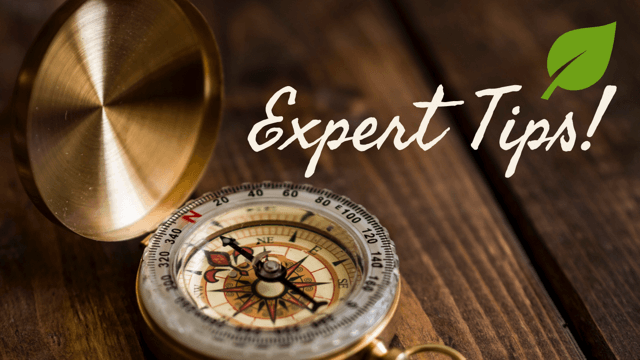
Find Undiscovered Treasures at Ancestry.com: Expert Tips
Ancestry.com is packed with all kinds of mostly-undiscovered genealogical treasures, and some of them you’ll never find from a search box.
Here, expert Nancy Hendrickson shares some favorite treasures, tips for finding those treasures, and helpful reminders for improving your genealogy research.
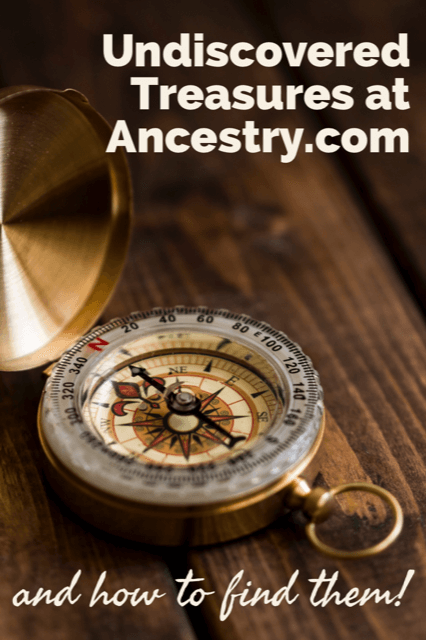
(We provide links for your convenience to the various online resources and some may be affiliate links for which we receive compensation at no additional expense to you. Thank you for your support.)
Ancestry.com is a “genealogy giant:” one of the four biggest global records resources. Whether you subscribe or have free access through your local library or Family History Center, you should not miss exploring this website for your family history.
Ancestry is also a financial investment. If you’ve been using the site for quite a while, you may be wondering if you are really getting all you can out of it’s vast genealogical record collections and many research tools.
Nancy Hendrickson, the author of The Unofficial Guide to Ancestry.com and the Unofficial Ancestry.com Workbook: A How-To Manual for Tracing Your Family Tree on the #1 Genealogy Website knows the website inside and out. Today she’s sharing four great tips for taking your research to the next level. In addition, we’ve added in some examples and additional things to consider. So let’s get started using Ancestry more effectively.
4 Tips for Using Ancestry.com More Effectively
1. Verify what you learn.
Any single record can be wrong, incomplete, or misread by you or by the person how indexed it. Double check the assertions made in the record by looking for that same information in additional sources. Be careful to make sure your sources weren’t getting their information from the same person or place. Otherwise, they’ll naturally say the same thing!
Nobody wants to discover conflicting information, of course. But you do want to know if something is inaccurate before it leads you down a wrong research path.
The best thing about verifying facts in additional sources is that sometimes you find NEW or BETTER information such as:
- parents’ names,
- a middle name that proves key to someone’s identity,
- or a burial place.
For example, let’s say you find an ancestor’s death date in the Social Security Death Index. While it’s a great source, don’t stop there!
Like any record, the SSDI is sometimes wrong and the information it contains is definitely limited. Use the Ancestry.com Card Catalog to see what records about death may be on the site for that time and place. You’ll find the Card Catalog under Search in the main menu.
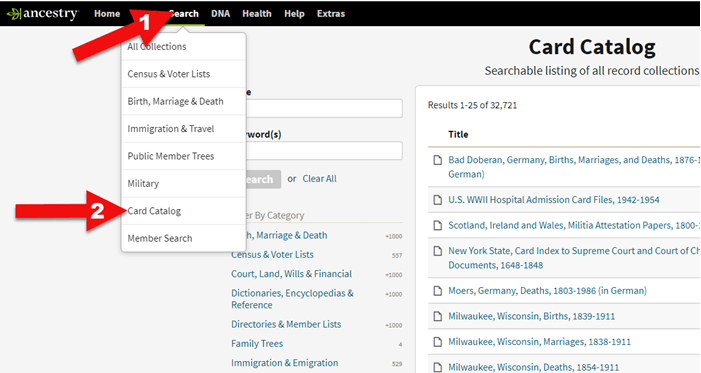
Ancestry Card Catalog
Use the filters on the left side to drill down to death records for the location you want. Remember that records collections have been created on a specific geographical level: try local, regional (such as state or province) as well as national levels.
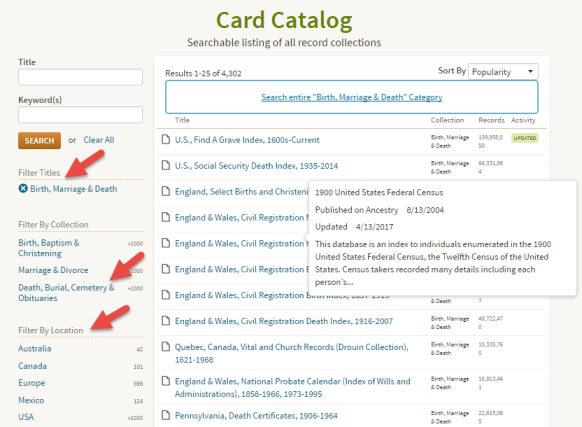
Using the Card Catalog search filters
2. Don’t just repeat what other people’s trees say.
Seeing the same information over and over can provide a false sense of accuracy. Remember, just because seven different online trees name the same parents for one of your ancestors doesn’t mean those are the correct parents. Those Ancestry users may all be misquoting the same wrong source without actually verifying the information!
You often come across likely matches in others’ trees when you review Ancestry’s automated “leaf” hints, or when you run a general search on a name. When you do, it’s simply an indication that the tree may be worth exploring. Here’s an example:
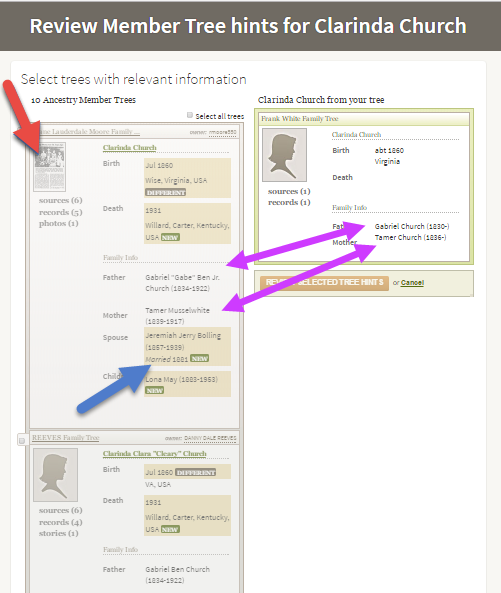
Exploring Ancestry Hints
Let’s take a closer look at this example.
The purple arrows: You can see that multiple pieces of very specific information are the same on your tree and another one.
The red arrow: You see sources attached to that person’s profile, such as the news article thumbnail image. (Note the difference with the record shown below, with just an empty profile image.) Yes, you will definitely want to review that news article!
The blue arrow: In addition to either of the above, you also see specific information that is unknown to you.
This tree profile looks promising enough you might naturally consider reviewing the tree hint and attaching it to yours. But then you wouldn’t be able to see the news article or other sources attached to that tree.
Instead, click the checkbox and then click the name of the tree to look at it and its attached sources:
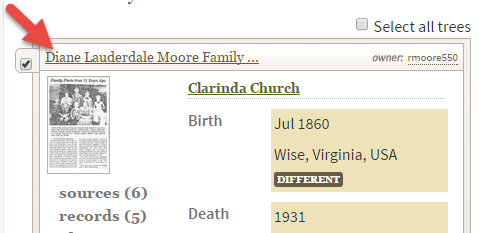
Select the tree to review it more closely.
Then you’ll be able to check out the news article along with the other sources and records attached to this person’s profile. You won’t just see what that person thinks about your common ancestor – you’ll see evidence of why she thinks it.
3. Ancestry.com has more than indexed historical documents.
Nancy reminds us that “Ancestry.com is a fantastic resource for old maps, stories, photos, published county histories, and more. For example, looking at the old maps in their collections can reveal the true nature of an ancestor’s daily life, hardships, travels, and more. And your chance of finding early American ancestors is high in county histories: there were fewer people and early settlers were talked about, even if the family wasn’t wealthy or prominent.”
Here are some of Nancy’s favorite collections at Ancestry:
U.S., Indexed County Land Ownership Maps, 1860-1918
This collection includes nearly 7 million records extracted from about 1,200 county and land ownership maps from across the country. These are indexed by property owners’ names.
According to the collection description, “They also indicate township and county boundaries and can include photos of county officers, landholders, and some buildings and homes.”
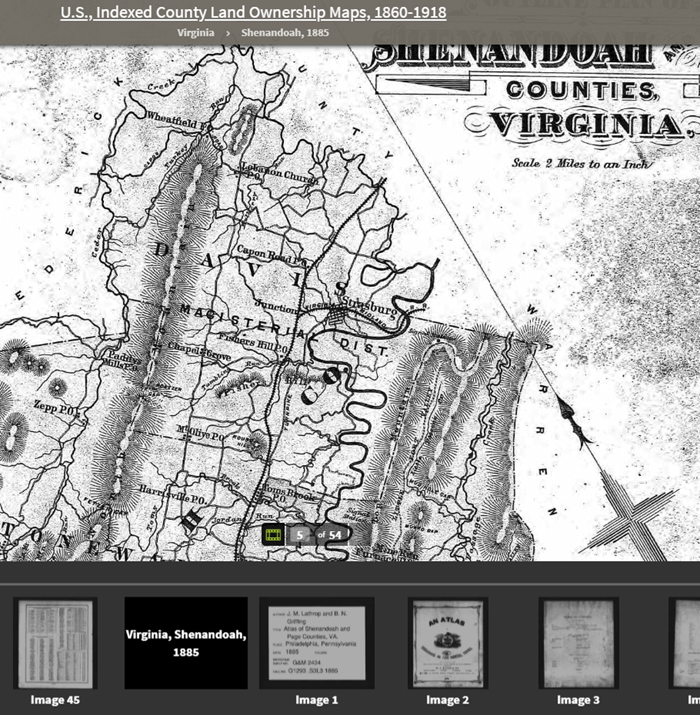
Example: Shenandoah Counties, Virginia – included in U.S., Indexed County Land Ownership Maps, 1860-1918
U.S., County and Regional Histories and Atlases, 1804-1984
This is a browse-only collection of “more than 2,200 volumes of county and regional histories from California, Illinois, Indiana, Michigan, New York, Ohio, Pennsylvania, and Wisconsin.
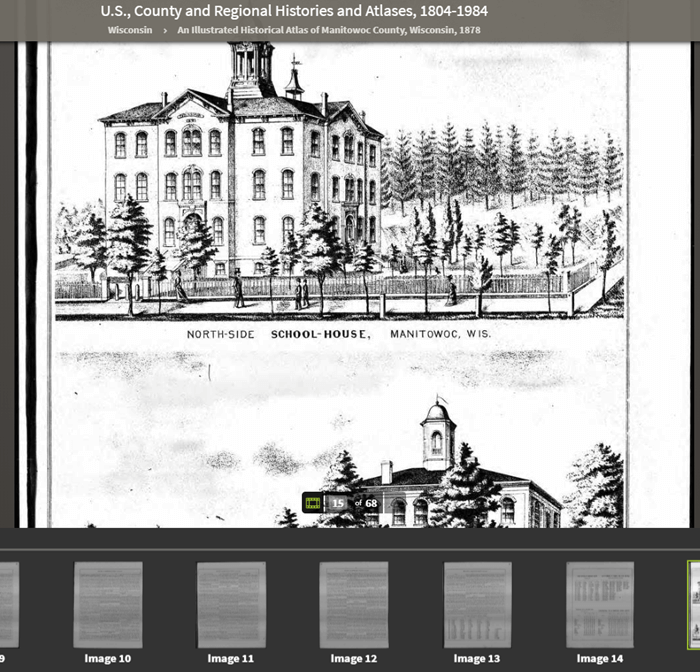
An Illustrated Historical Atlas of Manitowoc County, Wisconsin, 1878 in the U.S., County and Regional Histories and Atlases, 1804-1984 collection
In them you’ll find history, biographical sketches, maps, business notices, statistics and population numbers, pictures, descriptions of industry and business, stories of early settlement and pioneers, colleges and universities, military history, geography, and plenty of other details.”
Reminder: you can’t search this database by an ancestor’s name. Instead, look for places, and then start reading.
Historic Land Ownership and Reference Atlases, 1507-2000
A collection of maps and atlases detailing land areas that comprise the present-day United States and Canada, as well as various other parts of the world. It contains a variety of maps and atlases created for different scopes and purposes, including land ownership atlases and bird’s-eye view maps.

Warrant Plan Records in the Historic Land Ownership and Reference Atlases, 1507-2000 Collection at Ancestry
Land ownership atlases usually show the names of contemporary owners or occupants of land and structures.
Some of the maps depict countries and wider geographical areas, while others depict counties, cities, towns, and smaller geographical areas.
4. Expand your search to the other Ancestry resources on the Web
Ancestry owns a lot of other web resources. Search these too!
Nancy says, “They include Find A Grave, Fold3, and RootsWeb, one of the oldest online genealogy communities around. Don’t give up! Keep looking in other places for the information you want to find.”
Find A Grave
Search results from Ancestry.com do include Find A Grave entries. Many of these contain additional information about the deceased and links to their relatives. As always, be sure to confirm the information you find here.
Fold3
Fold3 is home to millions of U.S. military records. Ancestry.com subscribers can upgrade their subscription to include Fold3 access, or you can subscribe separately.
RootsWeb
RootsWeb is a free and long-lived family history web resource, now hosted by Ancestry.
“The primary purpose and function of RootsWeb.com is to connect people so that they can help each other and share genealogical research,” says the site. “Most resources on RootsWeb.com are designed to facilitate such connections.” You can use RootsWeb in a variety of ways: search it, contribute records, upload your family tree, post your family surnames on a board others can see, and more.
Ancestry has changed one of the ways RootsWeb users have traditionally connected: Mailing Lists. According to the website:
“Beginning March 2nd, 2020 the Mailing Lists functionality on RootsWeb will be discontinued. Users will no longer be able to send outgoing emails or accept incoming emails. Additionally, administration tools will no longer be available to list administrators and mailing lists will be put into an archival state. Administrators may save the email addresses in their list prior to March 2nd. After that, mailing list archives will remain available and searchable on RootsWeb. As an alternative to RootsWeb Mailing Lists, Ancestry message boards are a great option to network with others in the genealogy community. Message boards are available for free with an Ancestry registered account.”
Learn More about Using Ancestry
Nancy Hendrickson’s Book
Nancy shares many more Ancestry tips and treasures in her Unofficial Ancestry.com Workbook. To get the most out of this book read the section on using the Ancestry.com Catalog. Nancy does 95% of her research in the catalog. The workbook is divided into topics, such as military records, so choose a chapter that fits your current goals. It’s also important to not just read the workbook, but also do the exercises. They teach you Nancy’s thought processes for how she finds specific answers or approaches certain types of problems. Then you can apply the same concepts to your own research. Don’t miss the chapter on social history. That’s where you’ll dig into everyday life. And finally, take advantage of the forms that are included. They will help you log your findings and analyze what you’ve learned.
Genealogy Gems Article
Browse-only collections at Ancestry and other genealogy websites are sometimes viewed as inaccessible, but they are actually a hidden treasure. Click here to read How to Find and Browse Unindexed Records at Ancestry – The Better Browsing Checklist. In this article you’ll learn how to access these browse-only collections at Ancestry and expand your family history research.

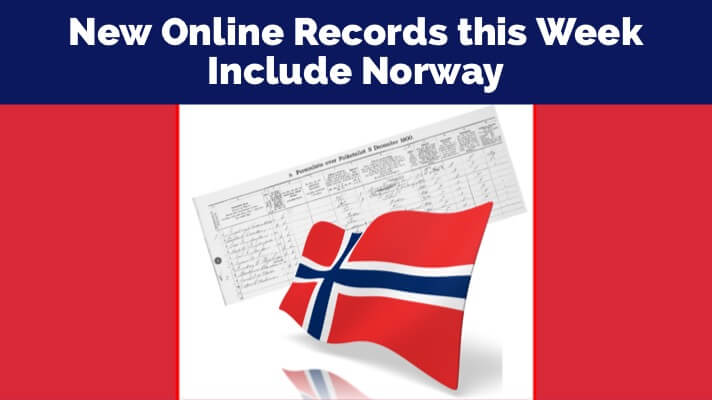
New Genealogy Records Online Include the Norway Census
Genealogy Giants MyHeritage and Ancestry have both added 3 Norway Census collections to their databases, totaling millions of new records. If you have Norwegian origins, these census documents contain valuable details about your ancestors that have been largely unavailable online until now. Then head over to FamilySearch for a massive German records collection now available for free on their website.
Norway Census Records
Both MyHeritage.com and Ancestry.com have recently released millions of new records from nationwide censuses conducted in Norway more than a century ago. It’s a treasure trove of information for anyone with Norwegian heritage.
MyHeritage provided a press release that has great information about these Norwegian records:
“The collections provide robust coverage for Norway’s entire population during a span of two decades and include valuable family history information. While some former Norway censuses were conducted only in select trading centers, these records are more comprehensive. The 6.5 million new records document names, households, dates of birth, marital status, relationships, and residential conditions, making them vital for anyone wishing to explore their Norwegian origins. Their publication marks the first time that Norwegian record collections of such high quality and granularity are available online.
The 1891 and 1900 collections include digital images of the original census documents, while the 1910 collection is an index consisting of transcribed records provided by the National Archives of Norway. The 1900 census was conducted by means that were, at the time, innovative: punch cards, which were then sorted and counted using electric tabulating machines. Of the 2.3 million records in the 1900 collection, 1.9 million records now have digital images of the original documents associated with the census index. Images of the remaining records will likewise be connected to the index in the near future.
Norwegian privacy laws restrict public access to census data for 100 years. Consequently, the 1910 census is the most recent one available to the public. This collection stands out as the first census conducted following the dissolution of Norway’s union with Sweden in 1905. It is also the first Norway census to record full birth dates, rather than only birth years.”
MyHeritage Users: Click here to access the Norwegian Census Collection at MyHeritage.
Ancestry.com Users: Click below to access the Norwegian Census Collections via Ancestry.com:
German Records Online at FamilySearch
The all-free genealogy records site FamilySearch.org has added a huge records collection this week as well for Germany. The Bavaria, Middle Franconia, Brenner Collection of Genealogical Records, 1550-1900 includes over 2.5 million records. This alphabetical collection of family group sheets was compiled from records from 97 parishes in the area and was originally created by Tobias Brenner and others between 1918 and 1945. The records are written in pencil on pre-printed forms in Gothic German handwriting.
Watch Finding German Villages
with James M. Beidler
Learn more about the Genealogy Giants
“Which genealogy records membership website should I use?” It’s one of the most-asked questions in genealogy—and this quick reference guide answers it! The Genealogy Giants guide is the perfect tool to quickly and easily compare all of the most important features of the four biggest international genealogy records membership websites: Ancestry.com, FamilySearch.org, Findmypast.com and MyHeritage.com. Then consult it every time your research budget, needs or goals change. Tables, bulleted lists and graphics make this guide as easy to use as it is informative. Available in both print and digital download.


Lacey Cooke
Lacey has been working with Genealogy Gems since the company’s inception in 2007. Now, as the full-time manager of Genealogy Gems, she creates the free weekly newsletter, writes blogs, coordinates live events, and collaborates on new product development. No stranger to working with dead people, Lacey holds a degree in Forensic Anthropology, and is passionate about criminal justice and investigative techniques. She is the proud dog mom of Renly the corgi.
Disclosure: This article contains affiliate links and Genealogy Gems will be compensated if you make a purchase after clicking on these links (at no additional cost to you). Thank you for supporting Genealogy Gems!



